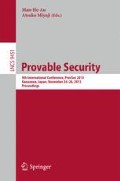Abstract
It is well-known that a protocol for any function can be constructed using only cards and various shuffling techniques (this is referred to as a card-based protocol). In this paper, we propose a new type of cards called regular polygon cards. These cards enable a new encoding for multi-valued inputs while the previous works can only handle binary inputs. We furthermore propose a new technique for constructing a card-based protocol for any n-ary function with small shuffle complexity. This is the first general construction in which the shuffle complexity is independent of the complexity (size/depth) of the desired functionality, although being directly proportional to the number of inputs. The construction furthermore supports a wide range of cards and encodings, including previously proposed types of cards. Our techniques provide a method for reducing the number of shuffles in card-based protocols.
Access this chapter
Tax calculation will be finalised at checkout
Purchases are for personal use only
Notes
- 1.
We stress that the two-card-per-bit encoding schemes are important since the one-card-per-bit encoding scheme [7] needs unnatural shuffle for computing the AND function. Thus, it is still meaningful to improve protocols under the two-cards-per-bit encoding schemes.
- 2.
We assume that the direction of flipping is predetermined.
- 3.
The number of cards in a stack would be revealed by the thickness of the stack.
- 4.
- 5.
We demonstrate how to securely obtain a cyclic shuffle. Let \(P_0, \cdots , P_{n-1}\) be the parties participating in the protocol. \(P_0\) chooses a uniformly random value \(r_0 \in \mathbb {Z}_k\) and applies \({\mathsf {cyc}}^{r_0}\) to \({\varvec{d}}\), and sends \({\mathsf {cyc}}^{r_0}({\varvec{d}})\) to \(P_1\). Similarly, \(P_i\) receives \({\varvec{d'}}\), chooses \(r_i \in \mathbb {Z}_k\), and sends \({\mathsf {cyc}}^{r_i}({\varvec{d'}})\) to \(P_{i+1}\). Finally, \(P_{n-1}\) outputs \({\mathsf {cyc}}^{r}({\varvec{d}})\) where \(r = r_0 + \cdots + r_{n-1}\). Nobody knows the uniform random value r except when all parties are corrupted by an adversary assuming parties are honest-but-curious.
- 6.
All operations except shuffles output a sequence in a deterministic way. However, shuffles output a sequence in a probabilistic way under a uniformly random value r.
- 7.
When there are no shuffles in a transcript, the vector \(r_i\) should be an empty vector.
- 8.
References
Crépeau, C., Kilian, J.: Discreet solitary games. In: Stinson, D.R. (ed.) CRYPTO 1993. LNCS, vol. 773, pp. 319–330. Springer, Heidelberg (1994)
den Boer, B.: More efficient match-making and satisfiability. In: Quisquater, J.-J., Vandewalle, J. (eds.) EUROCRYPT 1989. LNCS, vol. 434, pp. 208–217. Springer, Heidelberg (1990)
Mizuki, T., Asiedu, I.K., Sone, H.: Voting with a logarithmic number of cards. In: Mauri, G., Dennunzio, A., Manzoni, L., Porreca, A.E. (eds.) UCNC 2013. LNCS, vol. 7956, pp. 162–173. Springer, Heidelberg (2013)
Mizuki, T., Fumishige, U., Sone, H.: Securely computing XOR with 10 cards. Australas. J. Comb. 36, 279–293 (2006)
Mizuki, T., Kumamoto, M., Sone, H.: The five-card trick can be done with four cards. In: Wang, X., Sako, K. (eds.) ASIACRYPT 2012. LNCS, vol. 7658, pp. 598–606. Springer, Heidelberg (2012)
Mizuki, T., Shizuya, H.: A formalization of card-based cryptographic protocols via abstract machine. Int. J. Inf. Sec. 13, 15–23 (2014)
Mizuki, T., Shizuya, H.: Practical card-based cryptography. In: Ferro, A., Luccio, F., Widmayer, P. (eds.) FUN 2014. LNCS, vol. 8496, pp. 313–324. Springer, Heidelberg (2014)
Mizuki, T., Sone, H.: Six-card secure AND and four-card secure XOR. In: Deng, X., Hopcroft, J.E., Xue, J. (eds.) FAW 2009. LNCS, vol. 5598, pp. 358–369. Springer, Heidelberg (2009)
Niemi, V., Renvall, A.: Secure multiparty computations without computers. Theor. Comput. Sci. 191(1–2), 173–183 (1998)
Nishida, T., Hayashi, Y., Mizuki, T., Sone, H.: Card-based protocols for any boolean function. In: Jain, R., Jain, S., Stephan, F. (eds.) TAMC 2015. LNCS, vol. 9076, pp. 110–121. Springer, Heidelberg (2015)
Nishida, T., Mizuki, T., Sone, H.: Securely computing the three-input majority function with eight cards. In: Dediu, A.-H., Martín-Vide, C., Truthe, B., Vega-Rodríguez, M.A. (eds.) TPNC 2013. LNCS, vol. 8273, pp. 193–204. Springer, Heidelberg (2013)
Shinagawa, K., Mizuki, T., Schuldt, J., Nuida, K., Kanayama, N., Nishide, T., Hanaoka, G., Okamoto, E.: Secure multi-party computation using polarizing cards. In: Tanaka, K., Suga, Y. (eds.) IWSEC 2015. LNCS, vol. 9241, pp. 281–297. Springer, Heidelberg (2015)
Stiglic, A.: Computations with a deck of cards. Theor. Comput. Sci. 259(1–2), 671–678 (2001)
Acknowledgment
The authors would like to thank members of the study group “Shin-Akarui-Angou-Benkyou-Kai” for the valuable discussions and helpful comments, and thank the anonymous reviewers for their comments. This work was partially supported by JSPS KAKENHI Grant Numbers 26330001 and 26330151, Kurata Grant from The Kurata Memorial Hitachi Science and Technology Foundation, and JSPS A3 Foresight Program.
Author information
Authors and Affiliations
Corresponding author
Editor information
Editors and Affiliations
Rights and permissions
Copyright information
© 2015 Springer International Publishing Switzerland
About this paper
Cite this paper
Shinagawa, K. et al. (2015). Multi-party Computation with Small Shuffle Complexity Using Regular Polygon Cards. In: Au, MH., Miyaji, A. (eds) Provable Security. ProvSec 2015. Lecture Notes in Computer Science(), vol 9451. Springer, Cham. https://doi.org/10.1007/978-3-319-26059-4_7
Download citation
DOI: https://doi.org/10.1007/978-3-319-26059-4_7
Published:
Publisher Name: Springer, Cham
Print ISBN: 978-3-319-26058-7
Online ISBN: 978-3-319-26059-4
eBook Packages: Computer ScienceComputer Science (R0)

